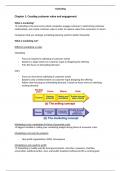Marketing
Chapter 1: Creating customer value and engagement
What is marketing?
marketing is the process by which companies engage customer's, build strong customer
relationships, and create customer value in order to capture value from customers in return.
Companies that use strategic marketing planning, perform better financially
What is marketing not?
Different marketing vs sales
Marketing
- Focus on long-term satisfying of customer needs
- Based to a larger extent on customer input in designing the offering
- Puts the focus on stimulating demand
Sales
- Focus on short-term satisfying of customer needs
- Based to only a limited extent on customer input designing the offering
- Rather than focusing on stimulating demand, it tends to focus more on satisfying
existing demand
Marketing is not a redundant in times of economic crisis
biggest mistake is cutting your marketing budget during times of economic crisis.
Marketing is not only for products
- Non-profit organization: WWF, Greenpeace
Marketing is only used for profit
Marketing is readily used by local governments, churches, museums, charities,
universities, political parties, zoos, and public hospitals (without profit as central goal)
,Marketing as ‘exchange’ (two-way) dyadic process
!! Exchange does not necessarily imply merely paying a money price !!
Value can only be created by co-creation between supplier and consumer:
- Supplier can provide a value proposition
- Offer only has value for the consumer upon usage with the goal of satisfying one’s
needs/wants/demand (‘value in use’)
Short-term customer wants vs long-term customer well-being
,The marketing process
1. Understand the marketplace, customer needs and wants
- Research the marketplace, customer's needs and wants
- Manage marketing information and customer data
2. Design a customer-driven marketing strategy
- Select customer's to serve: segmentation and targeting
- Design a value proposition: differentiation and positioning
3. Construct an integrated marketing program
- Product design and building strong brands
- Pricing and making attractive
- Place: making available
- Promotion: communicate customer value
4. Build profitable relationships and create
- CRM: building strong relations with target customer's
- PRM: building strong relations with marketing partners
5. Capture value from customers to create profit and customer equity
- Create customer satisfaction and delight
- Capture customer lifetime value
- Increase market share and share of customer's
Customer needs, wants and demands
!! watch out for marketing myopia !! look beyond product, to underlying customer needs
Marketing offering – Products, services, experiences
products, services, persons, places, organizations, information, ideas, offered to a market
to satisfy a need or want
A market = all actual and potential buyers of a product/service/…
Elements of a modern marketing system
Supplier company/competitors marketing intermediaries final users
- Each party in the system adds value
- Arrows represent relationships (partners and customers) that must be developed
and managed to create customer value and profitable customer relationships
, Designing a customer value-driven marketing strategy
1. Selecting customers to serve
2. Choosing a value proposition
3. Marketing management orientations
Marketing management = the art and science of choosing target markets and building
profitable relationships with them
Marketing management orientations
concepts under which organizations design and carry out their marketing strategies to
engage target customer's and build profitable relationships with them
Production concept (1900s - production)
- Products available and highly affordable
- Improving production and distribution efficiency
- When demand > supply
Product concept (1915 - quality)
- Products with the best quality, performance, innovative features
- Continuous product improvements
Selling concept (1930 - sales)
- Large-scale selling and promotion
- Unsought goods
- Aggressive selling … long-run CRM?
Marketing concept (1960 - needs)
Societal marketing concept (environment)
Short term customer wants vs. long term customer well-being triangle




